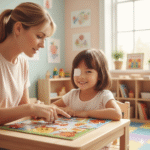Eye contact plays a crucial role in communication and helps children develop strong social connections. It’s normal for a child to occasionally avoid eye contact, but if it happens consistently, it’s important to consult a doctor to identify the underlying cause. The information below explains the symptoms, causes, risk factors, possible complications, and treatment options for children who have difficulty maintaining eye contact.
Symptoms of Poor Eye Contact in Children
1. Avoids direct eye contact during conversations – The child rarely looks into another person’s eyes while talking or listening.
2. Focuses on objects instead of faces – During interactions, the child tends to look at surrounding objects rather than the speaker’s face.
3. Struggles to follow verbal instructions without visual cues – They rely more on gestures or demonstrations to understand what’s being said.
4. Shows limited interest in social interactions – The child may appear withdrawn, hesitant to mingle, or uninterested in playing with others.
5. Depends heavily on non-verbal communication – Instead of using words, the child often communicates through pointing, gestures, or facial expressions.
Causes of Poor Eye Contact in Children
1. Autism Spectrum Disorder (ASD) – Children with ASD often find direct eye contact overwhelming or uncomfortable due to sensory sensitivities and differences in social communication.
2. Attention Deficit Hyperactivity Disorder (ADHD) – Children with ADHD may appear distracted or inattentive, making it harder for them to maintain steady eye contact during conversations.
3. Vision Problems – Poor eyesight or the need for corrective glasses can make focusing on faces difficult or tiring.
4. Strabismus (Lazy or Crossed Eyes) – Misalignment of the eyes can affect how a child perceives faces, leading to reduced or avoided eye contact.
5. Facial Sensory Processing Challenges – Some children are overly sensitive to facial expressions or proximity, making close visual interaction uncomfortable.
6. Social Communication Difficulties – Trouble understanding social cues or interpreting emotions can lead to reduced eye contact.
7. Emotional or Psychological Factors – Conditions such as social anxiety, low self-confidence, or emotional stress can make children hesitant to meet others’ gaze.
8. Limited Exposure to New Environments – Children who are not encouraged to explore or interact socially may lack opportunities to develop natural communication habits.
9. Excessive Screen Time – Spending long hours on screens can reduce real-world social engagement, limiting a child’s ability to practice and maintain eye contact.
Risk Factors That Affect a Child’s Eye Contact
The condition may be due to any family history of autism, ADHD or any other communication disorders, or because of premature birth or low birth weight, early brain injury or developmental delay, being in highly screen-based environments, and lack of interaction during early years.

What Happens If a Child Avoids Eye Contact
Improper eye contact might lead to communication delays, which cause trouble in understanding emotions, gestures, and conversations. Children may face social difficulties, such as struggling to make friends and not knowing how to build peer relationships. They may also face learning challenges, like difficulty in classroom participation and being unable to follow teachers’ instructions. In addition, they may develop low self-esteem, experience increased anxiety, and withdraw from group activities.
Treatment and Support for Improving Proper Eye Contact in Children
1. Consult a Pediatric Specialist or Developmental Doctor
The first and most important step is to consult a doctor if your child consistently avoids eye contact. A professional evaluation helps identify the underlying cause and rule out conditions like autism, ADHD, or other developmental delays.
2. Get a Comprehensive Developmental Assessment
After initial observation, your doctor may recommend a developmental or behavioral assessment to check for Autism Spectrum Disorder (ASD), ADHD, or learning difficulties that may affect communication and social interaction.
3. Schedule a Vision Check-up
Vision problems can sometimes cause children to avoid eye contact. Visiting an eye specialist ensures that poor eyesight, strabismus (crossed eyes), or other visual issues are properly treated.
4. Start Early Interventions and Therapies
Therapies play a vital role in improving communication and confidence. Speech and language therapy, occupational therapy, and behavioral therapy can help children improve their focus, social interaction, and ability to maintain eye contact naturally.
5. Encourage Eye Contact Through Daily Activities
Parents can build this skill at home by maintaining gentle eye contact during conversations, playing interactive games like peek-a-boo or hide-and-seek, and giving positive reinforcement when the child makes eye contact.
6. Reduce Screen Time and Increase Social Interaction
Encourage your child to spend more time interacting with family and friends rather than screens. Real-life conversations and playtime help develop stronger social and communication skills.
7. Follow Medical Advice and Prescribed Treatments
If your child’s doctor prescribes medication or therapy, ensure it’s followed under proper medical supervision. Consistency and patience are key to long-term improvement.
Early awareness and timely intervention can make a big difference in your child’s communication and social development. With proper guidance, therapy, and parental support, most children can learn to maintain healthy eye contact and build stronger social connections.




